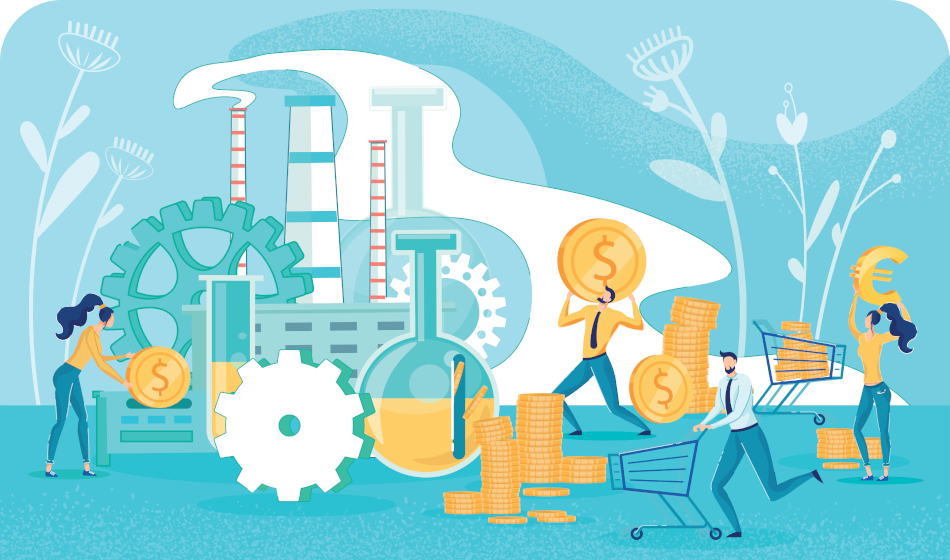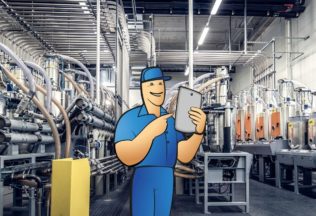HR in Manufacturing: Driving Efficiency in the Workforce
At its core, manufacturing relies above all on the workforce to make production happen, even if the operation is largely automated. Managing human resources in manufacturing has unique challenges and differences compared to other sectors. In this post, we delve into HR in manufacturing and look at its trends, challenges, and best practices.

You can also listen to this article:
What is human resource management?
Human resource management (HRM) is a strategic approach to the effective management of people within an organization to help it achieve its goals and objectives. It encompasses a variety of functions, including recruiting and hiring, employee relations, retention, benefits and compensation, training and development, and ensuring regulatory compliance.
HRM is essential to the success of any organization by helping to ensure that the right people are hired, that their skills are continuously developed, and that they remain motivated to perform at their best. It also plays a critical role in fostering a positive workplace culture, minimizing legal risks, informing performance management, and improving overall organizational productivity.
In the modern economic landscape, HR’s role in business management is constantly evolving. The HR department is increasingly viewed as a strategic partner involved in high-level decision-making. Across diverse sectors, HR is embracing digital technologies like data analytics and recruitment software to streamline HR processes and derive more actionable insights. It also deals with emerging HR challenges including remote and flexible work, mental health and well-being, inclusivity, etc.
The HR process
Human resource management involves several core processes that are critical for the effective functioning of an organization. These span the entirety of an employee’s lifecycle within an organization, from recruitment to retirement. Effective HRM does not view these as isolated but rather as interconnected, creating a comprehensive approach to managing human resources within an organization. Let’s go over the key processes.
Staffing
The first essential process within HRM is staffing. This involves developing a staffing plan based on the organization’s current and future needs, creating recruitment policies that align with the company’s goals and legal requirements, actively recruiting potential candidates, and finally, selecting the most suitable individuals through a selection process. Staffing is a balance of finding the right fit for the company culture while ensuring that the chosen candidate has the skills and experience needed to excel in the role.
Workplace policies and procedural rules
HR is responsible for developing, communicating, and enforcing workplace policies and procedural rules. These policies can range from conduct and dress code to more complex matters like handling conflicts of interest. Policies are aimed at creating a safe, respectful, and productive work environment. HR also establishes procedural rules that guide everyday operations which can include policies on communication, use of company property, or data security.
Compensation and benefits
Another key role of HR is developing and managing the compensation and benefits packages for employees – key factors in attracting and retaining top talent. This process involves determining competitive pay rates as well as offering healthcare benefits, bonuses, and retirement plans, and organizing vacations and sick leave. The goal is to provide a package that’s not only fair and attractive but also in line with the organization’s financial capabilities, strategic objectives, and legislation.
Employee retention
Besides recruiting and acclimatizing employees, retention is an HR function no less relevant. It revolves around motivating employees to stay within the organization. This cohesive process encompasses managing relationships and conflicts among co-workers, increasing inclusivity and involvement, improving workplace conditions, and ensuring a positive company culture. Regular employee feedback, recognition programs, and motivational events are often used to keep morale high and promote a sense of belonging.
Training and development
HRM also encompasses the training and development of employees which can include job skills and communication training, team-building exercises, legal training, etc. HR needs to ensure employees have the necessary skills to perform their current job duties and also prepare them for future roles within the organization. It pays to note that the effect of continuous employee development is a prime long-term driver of job satisfaction that gets often overlooked in businesses.
Alignment with legislation
Aside from people-oriented tasks, HR also needs to ensure the company adheres to employment laws and regulations. This includes compliance with labor and union laws, equal employment opportunity regulations, workplace safety standards, etc. In addition to working closely with legal teams, regular training and communication with employees is essential to ensure employees are aware of relevant legislation and their rights.
Worker safety
Lastly, HR is responsible for assuring worker safety. The HR manager implements safety policies, conducts safety training, and ensures the organization complies with safety and health regulations. In the event of a workplace accident, it also falls to HR to coordinate response efforts and facilitate any necessary investigations or changes to prevent future incidents.
The role of HR in manufacturing companies
While it might seem otherwise, HR plays a distinctive role in the manufacturing sector. The nature of work, the type of workforce, and the unique challenges in modern manufacturing all necessitate a specialized approach. Let’s go through the main peculiarities of HR in manufacturing.
- First of all, safety and regulatory compliance take center stage in most manufacturing companies. Above all, HR must ensure that policies to prevent workplace accidents, chronic illnesses, and exposure to harmful substances are in place, rigorously followed, and effectively communicated. Ideally, health and safety policies should go a step further and offer systematic ways of alleviating the physical strain that many manufacturing jobs demand while also helping to mitigate the risk of repetitive stress injuries.
- A challenging key difference for HR leaders in manufacturing lies in the much fiercer competition that exists across many manufacturing sectors for skilled workers, brought on by a widening skill gap and a shrinking pool of prequalified laborers. Many manufacturing sectors are experiencing staffing pressures due to the onset of automation and robotics, an aging workforce, and a pervasive reluctance of younger generations to work in manufacturing. Since recruitment can’t rely on large pools of potential employees, intuitive recruitment strategies are often favored such as partnerships with educational institutions, apprenticeships, or leveraging recruitment technology for talent acquisition.
- Related to the above is a heightened emphasis on retention. The attrition of skilled employees usually impacts the output of a manufacturing company much more than in other sectors, especially if abrupt. What’s more, manufacturers are often unable to offer popular benefits like work-from-home or flexible hours due to the hands-on nature of the work. This necessitates employing different motivation factors such as enhancing the manufacturing environment, diversifying tasks, or increasing involvement. Common retention strategies in manufacturing include competitive pay, extra bonuses and benefits, and self-development opportunities.
- Employee training and development lean heavily towards practical skills in manufacturing such as operating specific machinery or adapting to specific workflows and layouts. HR departments, therefore, often develop comprehensive onboarding and on-the-job training programs, and invest in specific skill set development initiatives. Touching on retention, the latter can also provide a motivational boost to workers by enabling a sense of personal development in positions where career development opportunities might be limited.
Key trends for HR in the manufacturing industry
Next, let’s take a look at 5 key trends that are affecting HR in the global manufacturing sector for 2023 and beyond.
- Digital transformation. As the fourth industrial revolution (industry 4.0) advances, the adoption of digital technology in HR is becoming inevitable. HR technologies in line with the digitization of the factory and shop floor help streamline workforce management processes, improve accuracy, and promote transparency. A digital shift in HR promises to enhance the employee experience and foster better engagement and retention.
- Workforce analytics. Digital solutions leveraging people analytics have been the norm in HRM in the corporate landscape for years. Now, the use of data analytics in HR is transforming talent management also in manufacturing. By utilizing analytics, HR can predict workforce trends, optimize recruitment and retention strategies, and make more informed decisions about workforce planning. This insight-driven approach promises to significantly enhance productivity and reduce costs associated with a high turnover rate.
- Ramped up safety and wellness measures. With the onset of the pandemic, a distinction emerged between essential and non-essential workforce. Manufacturing employees across a wealth of sectors fell into the former group as halting work simply wasn’t an option for many types of manufactured goods. This brought a renewed focus not only on health and safety measures but also on the well-being of workers.
- Focus on sustainability. Due to increasing awareness of global climate change, a focus on the environmental impact of manufacturing continues to shape the modern manufacturing landscape. This is having an effect also on staffing as more and more environmentally conscious would-be workers are influenced in their decisions for jobs by the sustainable manufacturing practices of the workplace.
- Diversity and inclusion: Building a diverse and inclusive workforce is increasingly becoming a strategic imperative for manufacturing companies. Diverse teams are shown to foster innovation, improve problem-solving capabilities, and reflect the diversity of customers and communities. HR plays a key role in promoting diversity and inclusion through fair recruitment practices, bias training, and inclusive policies.
5 HR recommendations for manufacturers in 2023
Finally, here are five recommendations for HR managers in manufacturing companies.
- Invest in training and development. Continuous learning opportunities not only upskill employees but also improve job satisfaction and engagement. Besides, preparing employees for future roles through succession planning can ensure business continuity and reduce recruitment costs. The onset of new technologies in manufacturing simply necessitates a higher focus on continuous learning. HR departments should adopt learning management systems and personalized training programs to improve performance but also enhance employee engagement and satisfaction.
- Focus on employee wellness. Employee wellness is increasingly becoming a strategic priority for manufacturers. Supporting the physical and mental health of employees and a good work-life balance is proven to lead to improved productivity and reduced absenteeism while improving employee morale and contributing to a positive company culture. Wellness initiatives range from enabling flexibility in working schedules and increasing cohesive communication with employees to programs and allowances promoting mental and physical health.
- Promote diversity and inclusion. A diverse and inclusive workforce offers numerous benefits for SMEs, including improved problem-solving, increased innovation, and enhanced employee engagement. HR should promote diversity and inclusion through fair hiring practices and a supportive work environment. Inclusive policies and bias training can further reinforce a culture of diversity.
- Enhance communication. Effective communication is crucial in any organization. This goes especially for manufacturing companies whose shop floor workers are often at risk of feeling left out of the larger company culture. Transparent and cohesive communication keeps employees informed, engaged, and committed to the company’s goals. Regular updates, open-door policies, and feedback mechanisms are all essential components of an effective communication strategy.
- Leverage digital technology. Technology can significantly enhance the efficiency and effectiveness of HR operations. HR software can automate time-consuming administrative tasks, allowing HR professionals to focus on strategic initiatives. Besides, data generated from these systems can be used for insightful analysis, enabling data-driven decision-making. Manufacturing management software solutions like ERPs and MRP systems with built-in employee reports, labor schedule dashboards, and personal production planning interfaces also significantly help enhance control over the company’s human resources.
In conclusion, HRM’s role in manufacturing goes beyond routine personnel management, addressing unique sector-specific challenges such as worker safety, skill gaps, and employee retention. As we progress in the digital era, HR professionals in manufacturing companies must adapt, emphasizing diversity, wellness, and the use of digital technologies. The promise remains: through effective HRM, manufacturing companies can enhance productivity, reduce turnover, and foster a more robust and productive business environment.
Key takeaways
- Human Resource Management (HRM) encompasses all processes that promote the effective management of people within an organization to help it achieve its goals and objectives. HRM includes an array of functions from recruitment and retention, employee relations, and benefits and compensation, to training and development, ensuring regulatory compliance, etc.
- The role of HR in manufacturing companies has distinct differences from other sectors. For example, there is a heightened focus on worker safety and well-being, recruitment strategies are more flexible as skilled workers are harder to come by, increasing retention and decreasing attrition carry much more weight than in corporate jobs, and there is a stronger focus on practical skills development.
- The most prominent trends for HR in manufacturing include an emphasis on digital transformation and worker analytics, a renewed focus on wellness and safety measures, and sustainability and diversity as prominent keywords driving recruitment.
- The top 5 recommendations for HR teams in manufacturing are to direct investments into training and personal development, focus on employee wellness, promote diversity and inclusion in the workforce, enhance communication within and between all levels of employees, and implement digital HR technology to help align the workforce with Industry 4.0.
Frequently asked questions
HRM, short for human resource management, is the strategic process of managing all aspects of the workforce of a company. The main functions of HR teams include recruitment, compensation, workplace policies, retention strategies, training and development, worker safety, and adherence to regulation.
In manufacturing, HR teams have many of the same functions as in other industries, however, with different focuses on certain HR aspects. For example, worker safety and health policies are of central importance in manufacturing. Additionally, recruitment is often more challenging due to a widening skill gap and an aging workforce. Retention of employees also carries a heightened focus in manufacturing because losing a skilled laborer can directly affect the manufacturing output. Finally, manufacturers also need to invest a lot more resources in training workers to adapt to in-house workflows.
Human resources can have a dramatic effect on productivity and the overall efficiency of a manufacturing company. This can be achieved by implementing hiring strategies to secure skilled labor, creating comprehensive training programs, fostering a positive work culture, increasing retention rates, and more. By ensuring the right people are in the right roles, satisfied with their position, well trained and adapted, productivity is naturally enhanced as workers are able to excel in their tasks.
You might also like: How to Communicate Effectively in a Manufacturing Company?




